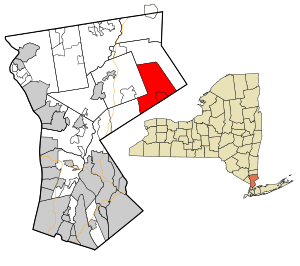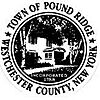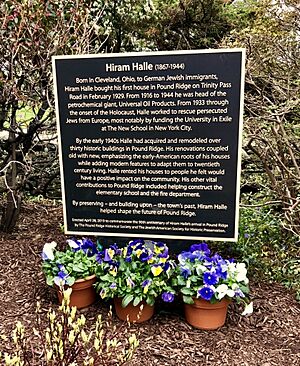Pound Ridge, New York facts for kids
Quick facts for kids
Pound Ridge, New York
|
||
|---|---|---|

NY State Route 137 in Pound Ridge
|
||
|
||

Location of Pound Ridge, New York
|
||
| Country | United States | |
| State | New York | |
| County | Westchester | |
| Founded | 1788 | |
| Area | ||
| • Total | 23.09 sq mi (59.80 km2) | |
| • Land | 22.31 sq mi (57.78 km2) | |
| • Water | 0.78 sq mi (2.02 km2) | |
| Elevation | 614 ft (187 m) | |
| Population
(2020)
|
||
| • Total | 5,082 | |
| • Density | 227.79/sq mi (87.95/km2) | |
| Time zone | UTC−5 (Eastern (EST)) | |
| • Summer (DST) | UTC−4 (EDT) | |
| ZIP Code |
10576
|
|
| Area code(s) | 914 | |
| FIPS code | 36-59685 | |
| GNIS feature ID | 0979394 | |
| Website | www.townofpoundridge.com | |
Pound Ridge is a lovely town located in Westchester County, New York, United States. In 2020, about 5,082 people called Pound Ridge home. It's in the eastern part of the county, sharing borders with towns like Lewisboro, Stamford, Connecticut, New Canaan, Connecticut, Bedford, New York, and North Castle.
Contents
History of Pound Ridge
Early Native American Life
In the early 1600s, the area of Pound Ridge was home to Native American groups. They spoke the Munsee language and were part of the Wappinger Confederacy. These groups included the Kitchawong, Siwanoy, and Tankiteke bands.
The Siwanoy people generally lived along the coast of Long Island Sound. The Tankiteke lived inland in eastern Westchester County. The Kitchawong were found near the Hudson River.
Kieft's War and the Pound Ridge Attack
The Wappinger Confederacy was involved in Kieft's War, which started in 1640. This war was due to disagreements over land, animals, trade, and taxes between the Dutch West India Company and the Native Americans.
In March 1644, a group of 130 Dutch soldiers attacked a Wappinger Confederacy village in what is now Pound Ridge. This event is known as the Pound Ridge Massacre. The soldiers surrounded the village at night, setting it on fire. Between 500 and 700 Native Americans were killed. Most of them were Tankiteke or Siwanoy. The Dutch lost only one soldier. This attack caused more deaths than any other event in the war. Soon after, Native American leaders sought peace in Stamford.
European Settlement and Land Ownership
Europeans first settled in Pound Ridge around 1718. Many of the first settlers came from Stamford. A large part of Pound Ridge was included in the town of North Castle when it was formed in 1721.
The northern part of Pound Ridge was part of a huge land grant called Van Cortlandt Manor. This grant covered over 86,000 acres. Families like the Lockwood, Scofield, and Fancher families were among the first to buy land and settle here. The name "Old Pound Ridge" was first used in 1737. It might have come from an old Native American game pound on a hill in the area.
For 50 years, there was a dispute over 3,000 acres in the Boutonville area. This was because of overlapping land grants. In 1788, the land was finally given to the Van Cortlandt family heirs. Much of this land is now part of the Ward Pound Ridge Reservation.
The American Revolutionary War
Pound Ridge was the site of a battle during the American Revolutionary War. On July 2, 1779, about 300 American rebels were attacked by 200 British soldiers. The British force was led by 24-year-old Banastre Tarleton. This attack was part of a plan to make George Washington's army move away from the Hudson River.
The American rebels had been warned of the attack. The American force included soldiers from Connecticut and local militia. The British force had light dragoons and infantry, including some Hessian Jagers.
Tarleton's troops left their base near Yonkers and rode through a storm. They attacked Pound Ridge from an unexpected northern route. A lookout spotted the British and warned the American commander. The American forces were scattered and retreated. The British pursued them for a while.
The British then returned to Pound Ridge. They were fired upon by some militia hiding nearby. The British burned the Presbyterian Church and the home of Major Lockwood. They took prisoners, cattle, weapons, and a battle flag before leaving. Tarleton also burned a church and a house in Bedford. The British were chased by Americans as they returned to their camp.
Reports on how many people were hurt or captured are different. One report says 10 Americans were wounded and eight captured. It also says two British were killed and four captured. The British burned the nearby towns of Bedford and Norwalk on July 11. During the war, both Patriots and Loyalists raided each other's homes in the region.
Pound Ridge in the 1800s
Pound Ridge officially became a town in 1788. The population grew from 707 in 1782 to 1,437 by 1830. During this time, Pound Ridge was a farming community. Families grew crops for themselves and raised cattle for meat and milk.
The town was also a center for making shoes. Nearly 150 families worked as shoemakers. They would get shoe parts from factories and then stitch them together at home. This was especially popular in winter when farmers had more free time. However, this home industry declined as factories started hiring full-time workers.
Basket making also became important, with 80 families involved. This industry was strongest in the Scotts Corners area, which was even called Basket Town. Baskets were used for many things, especially for the oyster industry along the Long Island Sound. But by the 1860s, basket prices fell due to competition and pollution affecting the oyster industry.
Pound Ridge sent 109 men to fight in the American Civil War. Many served in Connecticut and New York regiments. Sadly, some were killed in action, died from illness, or were wounded. The town raised money to help the soldiers and their families.
In 1869, the Stamford Water Company bought land to build a dam and create Trinity Lake. This lake held 450 million gallons of water for Stamford. Later, Siscowit Reservoir was also created. For about 20 years, from 1886, annual farmers' picnics were held at Trinity Lake, attracting up to 2,000 people.
Pound Ridge in the 1900s
The population of Pound Ridge dropped from 1,417 in 1860 to 515 in 1920. During this time, dairy farming became more common than general farming. Forests grew back on land that had been cleared.
In 1911, large fires burned hundreds of acres in the town. In 1916, there was a discussion about opening a Polio hospital in Pound Ridge. However, the town did not approve it. The town board even passed a rule that children from outside the town had to be checked by health officials before visiting. In 1917, Pound Ridge faced a Polio outbreak.
In 1925, Westchester County bought over 4,000 acres in northern Pound Ridge and Lewisboro. This land became the Pound Ridge Reservation. In 1938, it was renamed the Ward-Pound Ridge Reservation. From 1933 to 1940, a Civilian Conservation Corp camp was located there. About 200 workers improved roads, built bridges, planted trees, and constructed shelters and picnic areas.
Geography
Pound Ridge covers about 23.1 square miles. Most of this area, about 22.3 square miles, is land. The rest, about 0.8 square miles, is water.
The eastern and southern borders of the town are along the state line with Connecticut.
Population Information
| Historical population | |||
|---|---|---|---|
| Census | Pop. | %± | |
| 1790 | 1,062 | — | |
| 1800 | 1,266 | 19.2% | |
| 1810 | 1,249 | −1.3% | |
| 1820 | 1,359 | 8.8% | |
| 1830 | 1,437 | 5.7% | |
| 1840 | 1,407 | −2.1% | |
| 1850 | 1,486 | 5.6% | |
| 1860 | 1,471 | −1.0% | |
| 1870 | 1,194 | −18.8% | |
| 1880 | 1,034 | −13.4% | |
| 1890 | 830 | −19.7% | |
| 1900 | 823 | −0.8% | |
| 1910 | 725 | −11.9% | |
| 1920 | 515 | −29.0% | |
| 1930 | 602 | 16.9% | |
| 1940 | 806 | 33.9% | |
| 1950 | 1,234 | 53.1% | |
| 1960 | 2,573 | 108.5% | |
| 1970 | 3,792 | 47.4% | |
| 1980 | 4,009 | 5.7% | |
| 1990 | 4,550 | 13.5% | |
| 2000 | 4,726 | 3.9% | |
| 2010 | 5,104 | 8.0% | |
| 2020 | 5,082 | −0.4% | |
| U.S. Decennial Census | |||
In 2000, there were 4,726 people living in Pound Ridge, with 1,699 households. Most residents were White (95.54%), with smaller percentages of African American (1.21%), Asian (1.65%), and other races. About 2.45% of the population was Hispanic or Latino.
About 38% of households had children under 18 living with them. Most households (76.4%) were married couples. The average household had 2.77 people.
The population was spread out by age. About 26.1% were under 18, and 12.2% were 65 or older. The average age was 42 years. Most families in Pound Ridge earned a good income.
Schools
The local school for younger children is the Pound Ridge Elementary School. It is one of five K-5 schools in the Bedford Central School District. Older children travel by bus to the Fox Lane Campus in Bedford for middle and high school.
Communities and Locations in Pound Ridge
- Pound Ridge – This is the historic center of the town. It has the Pound Ridge Community Church, the Hiram Halle Memorial Library, and the Pound Ridge Museum. Many old buildings here were restored by Hiram Halle and are part of the Pound Ridge Historic District.
- Sarles Corners – This is a small community west of Scotts Corners. It was originally called Taylor's Corner.
- Scotts Corners – This community in the southern part of town is the main business area. You'll find the post office and firehouse here.
Local Media
The Westchester Journal-News, a daily newspaper, is the town's official newspaper.
Pound Ridge as a Film Location
Pound Ridge and the Pound Ridge Reservation have been used as settings for several movies:
- 1976 thriller Marathon Man
- 1997 film Jungle 2 Jungle
- 1997 HBO film In the Gloaming
Notable People
- Max Abramovitz (1908–2004), architect
- Eva Amurri (b. 1985), actress
- Tallulah Bankhead, actress
- Ellen Barkin, actress
- David Bloom, journalist
- Jerry Bock, composer
- George E. Bria, journalist
- Tom Brokaw (born 1940), journalist and author
- Blackleach Burritt, clergyman during the American Revolution
- Gabriel Byrne (born 1950), actor
- Zoe Caldwell, stage actress
- Howard Cosell (1918–1995), sportscaster
- Hume Cronyn, actor; husband of Jessica Tandy
- Melissa Claire Egan (born 1981), actress
- Ari Fleischer (born 1960), press secretary for U.S. President George W. Bush
- Richard Gere (born 1949), actor and producer
- Benny Goodman, jazz clarinetist
- Michael Gore, songwriter and producer
- Fred Gwynne (1926–1993), actor
- Hiram Halle (1867–1944), philanthropist and inventor
- Elizabeth Hand, author
- Evan Hunter, author and screenwriter
- Zach Iscol (born 1978), US Marine Corps veteran and entrepreneur
- Anne Jackson (1925–2016), actress
- Stephen Jenks, composer
- Eartha Kitt, actress
- Björn Kjellström, inventor of the modern compass
- Andrew Klaber, investor and philanthropist
- Ronnie Lee, Broadway actor and producer
- Blake Lively (born 1987), actress and wife of Ryan Reynolds
- Samuel D. Lockwood, 19th-century Illinois politician
- Stanley Lomas, television pioneer
- Carey Lowell, actress
- Ross Lowell (1926–2019), inventor and cinematographer
- Ali MacGraw (born 1939), actress
- Mike Myers (born 1963), actor
- Stuart Ostrow, Broadway producer
- Jane Pauley, journalist and author
- Maggie Q (born 1979), actress and model
- Steve Reich, composer
- Ryan Reynolds (born 1976), actor and husband of Blake Lively
- Tim Robbins, actor
- Steven C. Rockefeller, professor and philanthropist
- Robert Rubin (born 1938), former US Treasury Secretary
- Susan Sarandon, actress
- Lisl Steiner, photographer and filmmaker
- Martin Stone, producer of Howdy Doody
- Jessica Tandy, actress, wife of Hume Cronyn
- John Waite (b. 1952), lyricist and balladeer
- Eli Wallach (1915–2014), actor
- Jessica Walter (1941–2021), actress
- Vera Wang (born 1949), fashion designer
- Robert Whitehead (1916–2002), producer
- Sloan Wilson (1920–2003), author
See also
 In Spanish: Pound Ridge para niños
In Spanish: Pound Ridge para niños



